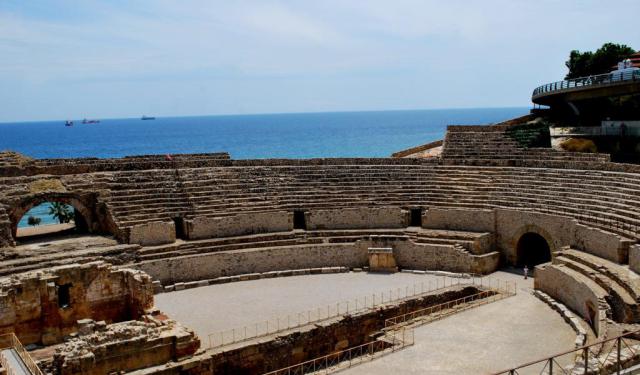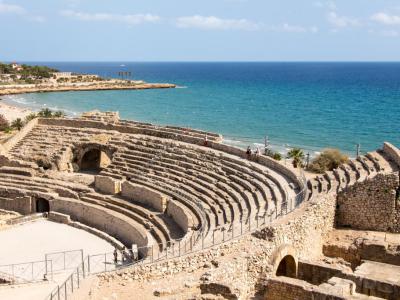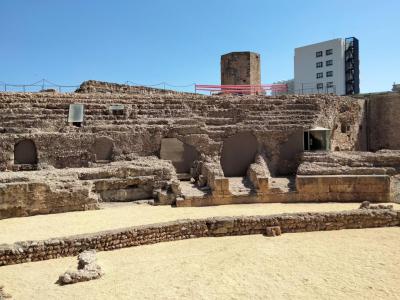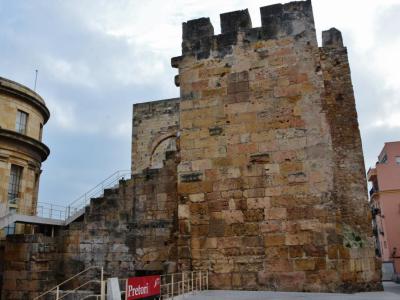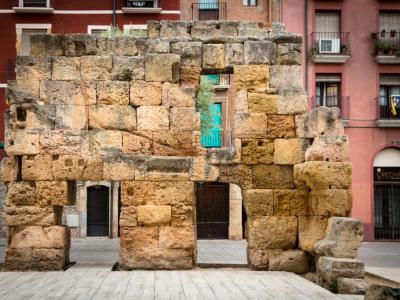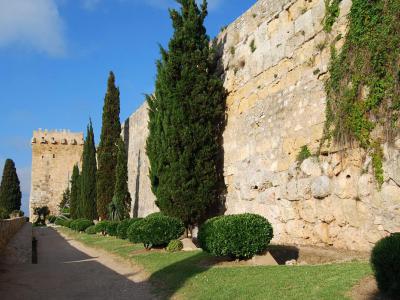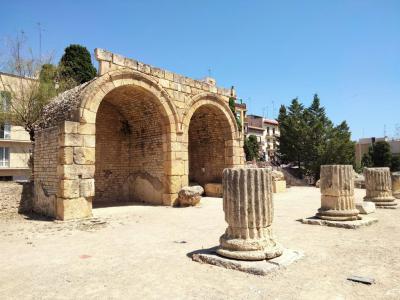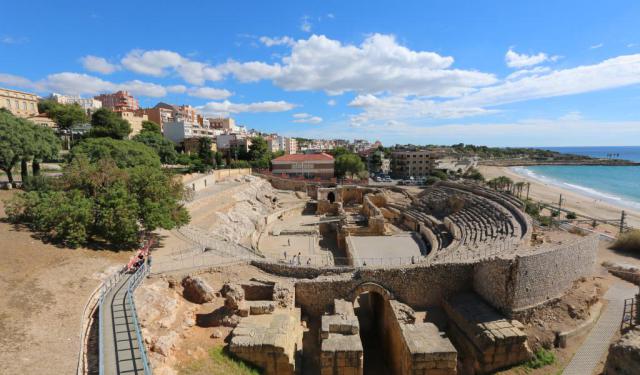Roman Ruins Walking Tour (Self Guided), Tarragona
The city of Tarraco, the capital of the Hispania Tarraconensis province, held significant prominence within the vast Roman Empire. The remnants of those days, concentrated in the heart of Tarragona, are the pivotal historical sites that contribute to its UNESCO World Heritage status.
Indeed, the city's acclaim largely stems from its Roman ruins, notably the 2nd-century AD Roman amphitheater. This monumental structure, capable of holding in its heyday up to 15,000 spectators, witnessed enthralling spectacles such as gladiatorial combat and other entertainments typical of ancient Roman culture.
Among other prominent sites are the vast Roman Circus, where chariot races once thrilled the crowds, and the imposing Roman Praetorium Tower (Torre del Pretorio Romana), a former symbol of authority.
Visitors can also explore the Garsa House (Ca La Garsa), a well-preserved example of Roman domestic architecture, along with the Tarragona Provincial Square (Forum Provincial Tarraco), providing insight into the civic life of the ancient city, and the Roman Walls of Tarragona (Muralles Romanes de Tarragona), a testament to the city's defensive prowess.
The Forum of the Colony (El Foro de la Colonia), once served as the political, social, and economic hub of Tarraco, showcases the power and influence of the Roman Empire in the region. For a deeper understanding of Tarragona's rich history, the National Archaeological Museum of Tarragona (Museu Nacional Arqueologic de Tarragona) houses a collection of artifacts and exhibits spanning thousands of years.
To experience the allure of Tarragona's Roman Ruins firsthand is to step into a world where ancient civilizations thrived and left their mark on the landscape. This tour offers you a captivating voyage to the heart of antiquity, inviting you to explore, learn, and appreciate the enduring legacy of the Roman Empire.
Indeed, the city's acclaim largely stems from its Roman ruins, notably the 2nd-century AD Roman amphitheater. This monumental structure, capable of holding in its heyday up to 15,000 spectators, witnessed enthralling spectacles such as gladiatorial combat and other entertainments typical of ancient Roman culture.
Among other prominent sites are the vast Roman Circus, where chariot races once thrilled the crowds, and the imposing Roman Praetorium Tower (Torre del Pretorio Romana), a former symbol of authority.
Visitors can also explore the Garsa House (Ca La Garsa), a well-preserved example of Roman domestic architecture, along with the Tarragona Provincial Square (Forum Provincial Tarraco), providing insight into the civic life of the ancient city, and the Roman Walls of Tarragona (Muralles Romanes de Tarragona), a testament to the city's defensive prowess.
The Forum of the Colony (El Foro de la Colonia), once served as the political, social, and economic hub of Tarraco, showcases the power and influence of the Roman Empire in the region. For a deeper understanding of Tarragona's rich history, the National Archaeological Museum of Tarragona (Museu Nacional Arqueologic de Tarragona) houses a collection of artifacts and exhibits spanning thousands of years.
To experience the allure of Tarragona's Roman Ruins firsthand is to step into a world where ancient civilizations thrived and left their mark on the landscape. This tour offers you a captivating voyage to the heart of antiquity, inviting you to explore, learn, and appreciate the enduring legacy of the Roman Empire.
How it works: Download the app "GPSmyCity: Walks in 1K+ Cities" from Apple App Store or Google Play Store to your mobile phone or tablet. The app turns your mobile device into a personal tour guide and its built-in GPS navigation functions guide you from one tour stop to next. The app works offline, so no data plan is needed when traveling abroad.
Roman Ruins Walking Tour Map
Guide Name: Roman Ruins Walking Tour
Guide Location: Spain » Tarragona (See other walking tours in Tarragona)
Guide Type: Self-guided Walking Tour (Sightseeing)
# of Attractions: 8
Tour Duration: 2 Hour(s)
Travel Distance: 2.9 Km or 1.8 Miles
Author: DanaOffice
Sight(s) Featured in This Guide:
Guide Location: Spain » Tarragona (See other walking tours in Tarragona)
Guide Type: Self-guided Walking Tour (Sightseeing)
# of Attractions: 8
Tour Duration: 2 Hour(s)
Travel Distance: 2.9 Km or 1.8 Miles
Author: DanaOffice
Sight(s) Featured in This Guide:
- Anfiteatro (Amphitheatre)
- Circ Roma (Roman circus)
- Torre del Pretorio Romana (Roman Praetorium Tower)
- Ca La Garsa (The Garsa House)
- Forum Provincial Tarraco (Tarragona Provincial Square)
- Muralles Romanes de Tarragona (Roman Walls of Tarragona)
- El Foro de la Colonia (The Forum of the Colony)
- Museu Nacional Arqueologic de Tarragona (National Archaeological Museum of Tarragona)
1) Anfiteatro (Amphitheatre) (must see)
Situated within the archaeological ensemble of Tarraco, a UNESCO World Heritage site, the Amphitheatre showcases the rich history and cultural significance of the region during the Roman era.
Constructed in the 2nd century AD, the Tarragona Amphitheatre was a pivotal center for gladiatorial contests, animal hunts, and other public spectacles that played a crucial role in Roman social and cultural life. The amphitheatre's strategic location, overlooking the Mediterranean Sea, further enhanced its appeal as a venue for grand events.
Key features of the Tarragona Amphitheatre include its elliptical shape, well-preserved seating tiers, and a network of tunnels and chambers beneath the arena floor. The elliptical design, a hallmark of Roman amphitheatres, allowed for optimal visibility and acoustics, ensuring that the audience could witness the events with maximum impact.
The seating tiers, arranged in a series of concentric rings, could accommodate thousands of spectators, emphasizing the amphitheatre's role as a communal space for entertainment and social gatherings. The tiered seating also reflected the hierarchical structure of Roman society, with different sections designated for various social classes.
Beneath the arena floor, a complex system of tunnels and chambers served practical purposes, facilitating the movement of gladiators, animals, and stage props during performances. These subterranean spaces provided a backstage area for the elaborate spectacles that unfolded above ground.
Today, the Tarragona Amphitheatre stands as a well-preserved archaeological site, inviting visitors to explore its ancient grandeur. The site offers panoramic views of the surrounding landscape. Interpretative displays and guided tours contribute to a deeper understanding of the historical context and significance of this iconic structure.
Constructed in the 2nd century AD, the Tarragona Amphitheatre was a pivotal center for gladiatorial contests, animal hunts, and other public spectacles that played a crucial role in Roman social and cultural life. The amphitheatre's strategic location, overlooking the Mediterranean Sea, further enhanced its appeal as a venue for grand events.
Key features of the Tarragona Amphitheatre include its elliptical shape, well-preserved seating tiers, and a network of tunnels and chambers beneath the arena floor. The elliptical design, a hallmark of Roman amphitheatres, allowed for optimal visibility and acoustics, ensuring that the audience could witness the events with maximum impact.
The seating tiers, arranged in a series of concentric rings, could accommodate thousands of spectators, emphasizing the amphitheatre's role as a communal space for entertainment and social gatherings. The tiered seating also reflected the hierarchical structure of Roman society, with different sections designated for various social classes.
Beneath the arena floor, a complex system of tunnels and chambers served practical purposes, facilitating the movement of gladiators, animals, and stage props during performances. These subterranean spaces provided a backstage area for the elaborate spectacles that unfolded above ground.
Today, the Tarragona Amphitheatre stands as a well-preserved archaeological site, inviting visitors to explore its ancient grandeur. The site offers panoramic views of the surrounding landscape. Interpretative displays and guided tours contribute to a deeper understanding of the historical context and significance of this iconic structure.
2) Circ Roma (Roman circus)
The Roman Circus stands as a captivating archaeological site that transports visitors back in time to the grandeur of ancient Roman entertainment and civic life. This well-preserved structure is a testament to the engineering prowess and cultural sophistication of the Roman Empire, showcasing the significance of Tarraco, the ancient Roman name for Tarragona, as a regional hub.
Constructed in the 1st century AD, the Roman Circus was primarily used for chariot races, a popular and thrilling spectacle in Roman society. The layout of the circus follows a traditional Roman design, featuring an elongated racetrack with semicircular ends, known as the spina, and tiered seating for spectators. The arena could accommodate thousands of enthusiastic onlookers who gathered to witness the exhilarating races and other public events.
The remnants of the Roman Circus offer a vivid glimpse into the scale and structure of the original circus. The elongated track, marked by well-preserved barriers and central spina, provides insight into the logistics of chariot races and the grandeur of the events held here. The spectator stands, arranged in a horseshoe shape, showcase the Romans' architectural ingenuity in optimizing sightlines for the audience.
The Roman Circus also served broader civic and social functions beyond chariot races. It was a multifunctional space used for public gatherings, religious ceremonies, and other communal events. The circus played a central role in the social and cultural life of Tarraco, reflecting the Roman emphasis on public entertainment and communal bonding.
Today, the site is carefully preserved, allowing modern visitors to walk through the remnants of the Roman Circus. Interpretative displays and informational signage contribute to a richer understanding of the historical context and significance of this archaeological gem.
Constructed in the 1st century AD, the Roman Circus was primarily used for chariot races, a popular and thrilling spectacle in Roman society. The layout of the circus follows a traditional Roman design, featuring an elongated racetrack with semicircular ends, known as the spina, and tiered seating for spectators. The arena could accommodate thousands of enthusiastic onlookers who gathered to witness the exhilarating races and other public events.
The remnants of the Roman Circus offer a vivid glimpse into the scale and structure of the original circus. The elongated track, marked by well-preserved barriers and central spina, provides insight into the logistics of chariot races and the grandeur of the events held here. The spectator stands, arranged in a horseshoe shape, showcase the Romans' architectural ingenuity in optimizing sightlines for the audience.
The Roman Circus also served broader civic and social functions beyond chariot races. It was a multifunctional space used for public gatherings, religious ceremonies, and other communal events. The circus played a central role in the social and cultural life of Tarraco, reflecting the Roman emphasis on public entertainment and communal bonding.
Today, the site is carefully preserved, allowing modern visitors to walk through the remnants of the Roman Circus. Interpretative displays and informational signage contribute to a richer understanding of the historical context and significance of this archaeological gem.
3) Torre del Pretorio Romana (Roman Praetorium Tower)
The Roman Praetorium Tower is situated in one corner of what was once an expansive porticoed plaza, the bustling heart of the provincial forum in Hispania Citerior, one of the grand provinces of the Roman Empire.
The tower, a formidable remnant of the past, has witnessed the evolution of Tarragona through various epochs. Originally part of the provincial forum, it later transformed into the medieval king's castle. Over the centuries, it served as a barracks, a prison, and endured the tests of modern and contemporary times.
As you explore the Torre del Pretorio Romana, you'll discover its integration with the Roman circus vaults and its strategic location within the city's urban fabric. The tower once boasted stairs connecting the lower city to the provincial forum, highlighting its central role in the civic life of ancient Tarraco.
Ascending the tower offers a panoramic spectacle, revealing some of the city's most iconic landmarks. The Roman amphitheater, the sandy shores, the historic Cathedral, the boundless Mediterranean expanse, and the silhouette of the ancient city unfold before your eyes. This vantage point has become a beloved destination for capturing stunning photographs, allowing visitors to glimpse the city's beauty through the lens of history.
Before reaching the upper terrace, a noteworthy stop is the sarcophagus adorned with intricate reliefs. This ancient funerary monument narrates the dramatic Greek myth of Hippolytus, Theseus, and Phaedra on its four sides. It adds a layer of mythological richness to the historical tapestry woven by the Torre del Pretorio Romana.
The tower, a formidable remnant of the past, has witnessed the evolution of Tarragona through various epochs. Originally part of the provincial forum, it later transformed into the medieval king's castle. Over the centuries, it served as a barracks, a prison, and endured the tests of modern and contemporary times.
As you explore the Torre del Pretorio Romana, you'll discover its integration with the Roman circus vaults and its strategic location within the city's urban fabric. The tower once boasted stairs connecting the lower city to the provincial forum, highlighting its central role in the civic life of ancient Tarraco.
Ascending the tower offers a panoramic spectacle, revealing some of the city's most iconic landmarks. The Roman amphitheater, the sandy shores, the historic Cathedral, the boundless Mediterranean expanse, and the silhouette of the ancient city unfold before your eyes. This vantage point has become a beloved destination for capturing stunning photographs, allowing visitors to glimpse the city's beauty through the lens of history.
Before reaching the upper terrace, a noteworthy stop is the sarcophagus adorned with intricate reliefs. This ancient funerary monument narrates the dramatic Greek myth of Hippolytus, Theseus, and Phaedra on its four sides. It adds a layer of mythological richness to the historical tapestry woven by the Torre del Pretorio Romana.
4) Ca La Garsa (The Garsa House)
The Garsa House is an architectural gem situated within the archaeological area of the provincial forum in Tarragona. This historical building, predominantly constructed using reused Roman bricks, unveils remnants of a distinctive structure characterized by two rooms adorned with diaphragmatic arches. The architectural ensemble also includes a portico that gracefully opens onto the adjacent square, while a vanguard extends its presence into the former Jewry square.
The remarkable architecture of Garsa House, both aesthetically pleasing and functional, serves as the sole architectural vestige reflecting the daily life and activities of the Jewish community in Tarragona. The Jewish presence in this location persisted uninterrupted from 1238 to 1492, making the building a poignant testament to the city's diverse cultural tapestry.
Although much of the original building has been lost to the ravages of time and development, the medieval arches and fragments of the late Roman wall endure, protected as a cultural asset of local interest. The remains provide a captivating glimpse into the architectural sophistication of the past and the intricate interplay of arches that once formed a rectangular room at ground floor level.
Three diaphragmatic arches, pointed and parallel to the facade of Angels Square, showcase the craftsmanship of a bygone era. Adjacent to these, two smaller perpendicular arcades add to the architectural finesse. A portico structure with yet another pointed arch precedes the main building, with an upper-level arch mirroring the dimensions of those below. The remnants also reveal traces of a chapel dedicated to the Virgin of the Angels, lost during the course of modern demolitions, possibly dating back to the 18th century.
In Talavera Street, neighboring the Garsa House, two preserved pointed arches stand as echoes of the architectural elegance that once defined the area. The building's composition includes a combination of ashlar and brick, attesting to the craftsmanship of its creators.
The remarkable architecture of Garsa House, both aesthetically pleasing and functional, serves as the sole architectural vestige reflecting the daily life and activities of the Jewish community in Tarragona. The Jewish presence in this location persisted uninterrupted from 1238 to 1492, making the building a poignant testament to the city's diverse cultural tapestry.
Although much of the original building has been lost to the ravages of time and development, the medieval arches and fragments of the late Roman wall endure, protected as a cultural asset of local interest. The remains provide a captivating glimpse into the architectural sophistication of the past and the intricate interplay of arches that once formed a rectangular room at ground floor level.
Three diaphragmatic arches, pointed and parallel to the facade of Angels Square, showcase the craftsmanship of a bygone era. Adjacent to these, two smaller perpendicular arcades add to the architectural finesse. A portico structure with yet another pointed arch precedes the main building, with an upper-level arch mirroring the dimensions of those below. The remnants also reveal traces of a chapel dedicated to the Virgin of the Angels, lost during the course of modern demolitions, possibly dating back to the 18th century.
In Talavera Street, neighboring the Garsa House, two preserved pointed arches stand as echoes of the architectural elegance that once defined the area. The building's composition includes a combination of ashlar and brick, attesting to the craftsmanship of its creators.
5) Forum Provincial Tarraco (Tarragona Provincial Square)
The Provincial Forum of Tarraco is a significant Roman archaeological site, covering an expansive area of 18 hectares. Forming an integral part of the Archaeological Ensemble of Tarraco, alongside other Roman remnants in the city, it earned recognition as a UNESCO World Heritage Site in 2000. Emperor Vespasian initiated its construction in 73 AD, and it remained in use until the 5th century.
The focal point of worship within the forum has since been occupied by structures such as the Cathedral and other edifices. Emperor Vespasian's directive led to the establishment of this forum, which served various civic and religious functions. The square witnessed significant activities until the 5th century when the surrounding buildings underwent transformations into private residences.
In subsequent centuries, particularly from the 12th century onward, the interior of the square underwent urbanization, and a street layout was implemented, preserving its historical footprint to the present day. This area now corresponds to the intricate network of streets constituting a substantial portion of Tarragona's medieval district, reflecting the enduring historical legacy of the Provincial Forum of Tarraco.
The focal point of worship within the forum has since been occupied by structures such as the Cathedral and other edifices. Emperor Vespasian's directive led to the establishment of this forum, which served various civic and religious functions. The square witnessed significant activities until the 5th century when the surrounding buildings underwent transformations into private residences.
In subsequent centuries, particularly from the 12th century onward, the interior of the square underwent urbanization, and a street layout was implemented, preserving its historical footprint to the present day. This area now corresponds to the intricate network of streets constituting a substantial portion of Tarragona's medieval district, reflecting the enduring historical legacy of the Provincial Forum of Tarraco.
6) Muralles Romanes de Tarragona (Roman Walls of Tarragona)
Declared a Cultural Heritage Asset in 1884, the Roman Walls of Tarragona are an invaluable heritage site. Constructed in the 2nd century BC, the Roman wall played a pivotal role in the early development of Tarraco. Initially spanning approximately 3,500 meters, only about one kilometer of the original wall remains preserved in the present-day old city. This makes it one of the oldest Roman constructions outside of Italy.
The primitive military settlement that gave rise to Tarraco saw the initial construction of a simple wooden stake wall. However, with the city evolving into a strategic Roman stronghold, reinforcements arrived from Rome, prompting the need for stronger defenses. Between 217 and 197 BC, the first stone wall was erected, featuring Cyclopean locks reinforced with towers at vulnerable points. Towers such as the Archbishop, Capital, and Minerva bear witness to this early phase.
Around 150 to 125 BC, the wall underwent significant transformations, expanding in length, height, and width to encompass the entire city, including the port. Beyond a defensive structure, the wall became a defining element of the urban space during this period. The second-phase wall featured a megalithic base, 1.5 to 2 meters high, supporting ashlar facings forming compartments.
The Archaeological Promenade meanders through both the ancient Roman and contemporary curtain walls, adorned with tranquil gardens, evocative poetry, and informative historical insights.
The primitive military settlement that gave rise to Tarraco saw the initial construction of a simple wooden stake wall. However, with the city evolving into a strategic Roman stronghold, reinforcements arrived from Rome, prompting the need for stronger defenses. Between 217 and 197 BC, the first stone wall was erected, featuring Cyclopean locks reinforced with towers at vulnerable points. Towers such as the Archbishop, Capital, and Minerva bear witness to this early phase.
Around 150 to 125 BC, the wall underwent significant transformations, expanding in length, height, and width to encompass the entire city, including the port. Beyond a defensive structure, the wall became a defining element of the urban space during this period. The second-phase wall featured a megalithic base, 1.5 to 2 meters high, supporting ashlar facings forming compartments.
The Archaeological Promenade meanders through both the ancient Roman and contemporary curtain walls, adorned with tranquil gardens, evocative poetry, and informative historical insights.
7) El Foro de la Colonia (The Forum of the Colony)
The Forum of the Colony served as the hub for Tarraco's primary commercial, administrative, recreational, and social activities. Distinguished from other Roman cities, Tarragona's forum deviated from the typical intersection of the cardo and the decumanus, finding its place in the lower part of the city.
Positioned within the residential zone, adjacent to the walls, and atop a hill providing excellent visibility of the port, this forum, dating back to the first half of the 1st century BC, held paramount importance. It functioned as the administrative center for the local government of the colony, served as a religious and social focal point, and operated as a public market accessible to all city inhabitants.
Comprising a spacious square with public edifices, temples, a basilica, the curia, commercial establishments, and statues honoring prominent figures of Rome and Tarraco, the forum offers a glimpse into the city's vibrant past. Notably, a visit to the forum reveals that the contemporary streets surrounding the Roman remnants are situated at a lower elevation than the monument. These streets, resembling trenches, were established in the early 20th century.
The varying topography of Tarraco underscores the city's evolution, with some areas existing at a lower level than the ancient Roman city due to shifts in relief over time.
Positioned within the residential zone, adjacent to the walls, and atop a hill providing excellent visibility of the port, this forum, dating back to the first half of the 1st century BC, held paramount importance. It functioned as the administrative center for the local government of the colony, served as a religious and social focal point, and operated as a public market accessible to all city inhabitants.
Comprising a spacious square with public edifices, temples, a basilica, the curia, commercial establishments, and statues honoring prominent figures of Rome and Tarraco, the forum offers a glimpse into the city's vibrant past. Notably, a visit to the forum reveals that the contemporary streets surrounding the Roman remnants are situated at a lower elevation than the monument. These streets, resembling trenches, were established in the early 20th century.
The varying topography of Tarraco underscores the city's evolution, with some areas existing at a lower level than the ancient Roman city due to shifts in relief over time.
8) Museu Nacional Arqueologic de Tarragona (National Archaeological Museum of Tarragona)
The National Archaeological Museum of Tarragona, established in the mid-nineteenth century as a Provincial Museum, holds the distinction of being the oldest institution of its kind in Catalonia. Throughout its rich history, it has evolved into a pivotal center dedicated to the recovery, preservation, research, and dissemination of the cultural heritage of the Roman city of Tarraco and its surrounding regions.
Situated in modern Tarragona, the museum grapples with the historical and monumental significance of Tarraco. It faces the challenges of its location within a city that has grown and developed over time. As a response, the National Archaeological Museum of Tarragona has directed its research programs towards investigating, preserving, and showcasing the Roman world, the Romanization of the Iberian Peninsula, and Tarraco's pivotal role as the capital of one of the largest provinces in the Roman Empire.
In addition to housing the Archaeological Museum, the MNAT oversees the Early Christian Museum and Necropolis, along with the Roman villas of Els Munts (Altafulla) and Centcelles (Constantí). The organizational purview extends to iconic monuments such as the Arch of Berà and Scipios’ Tower, situated along the Via Augusta, as well as the ongoing restoration of the Roman Theatre. This comprehensive approach allows the MNAT to offer a multifaceted exploration of the rich archaeological and historical heritage of Tarragona and its Roman past.
Situated in modern Tarragona, the museum grapples with the historical and monumental significance of Tarraco. It faces the challenges of its location within a city that has grown and developed over time. As a response, the National Archaeological Museum of Tarragona has directed its research programs towards investigating, preserving, and showcasing the Roman world, the Romanization of the Iberian Peninsula, and Tarraco's pivotal role as the capital of one of the largest provinces in the Roman Empire.
In addition to housing the Archaeological Museum, the MNAT oversees the Early Christian Museum and Necropolis, along with the Roman villas of Els Munts (Altafulla) and Centcelles (Constantí). The organizational purview extends to iconic monuments such as the Arch of Berà and Scipios’ Tower, situated along the Via Augusta, as well as the ongoing restoration of the Roman Theatre. This comprehensive approach allows the MNAT to offer a multifaceted exploration of the rich archaeological and historical heritage of Tarragona and its Roman past.
Walking Tours in Tarragona, Spain
Create Your Own Walk in Tarragona
Creating your own self-guided walk in Tarragona is easy and fun. Choose the city attractions that you want to see and a walk route map will be created just for you. You can even set your hotel as the start point of the walk.
Tarragona Introduction Walking Tour
Nestled in the southern part of Catalonia, Spain, Tarragona is a coastal city boasting an abundance of ancient Roman ruins, rolling mountains, and magnificent beaches.
Shrouded in myth and mystery, Tarragona carries a name whose origins remain debated-linked to figures like Tarraho or Tearcon the Ethiopian, a seventh-century BC pharaoh. Its true founding date is also obscured in time.
... view more
Tour Duration: 2 Hour(s)
Travel Distance: 2.7 Km or 1.7 Miles
Shrouded in myth and mystery, Tarragona carries a name whose origins remain debated-linked to figures like Tarraho or Tearcon the Ethiopian, a seventh-century BC pharaoh. Its true founding date is also obscured in time.
... view more
Tour Duration: 2 Hour(s)
Travel Distance: 2.7 Km or 1.7 Miles
The Most Popular Cities
/ view all
